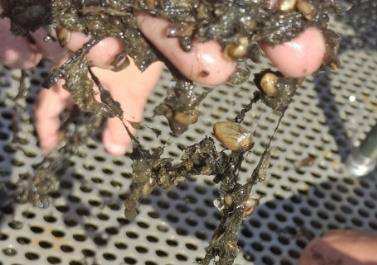The late fall is a busy time for Genoa NFH’s freshwater mussel program. Staff and volunteers have been gathering juvenile mussels from various growing season culture systems and getting them settled into over-winter systems in the mussel building at the Hatchery. Partnerships with the U.S. Army Corps of Engineers’ Blackhawk Park and the National Mississippi River Museum and Aquarium are vital to our mussel production and culture efforts.

Culture tanks in the MARS trailer.
The trailer is placed at Blackhawk Park for the growing season, with thousands of juvenile mussels growing in each tank. The trailer and juvenile mussels are brought back to GNFH at the end of the growing season.
This season’s production focused on 9 species of mussels, and we had 14 species in culture in the MARS rearing trailer at Blackhawk Park or in mussel cages and SUPSYs at the River Museum. Plain Pocketbook, Black Sandshell and Higgin’s Eye mussels were stocked in several locations in Iowa, supporting the Iowa DNR’s mussel restoration efforts. Rainbow Mussel juveniles are being reared in culture and were stocked into the Mukwonago River supporting Wisconsin DNR restoration efforts, Fatmucket are being reared to help National Park Service efforts to restore mussels to the Cuyahoga River, and Pink Heelpslitter, Fragile Papershell and Eastern Lampmussel are in culture to support the St Regis Mohawk Tribe’s efforts to restore native mussel populations in Tribal territories. Late in the fall, Genoa NFH biologists collaborated with USGS partners to produce Salamander mussel juveniles for research and population restoration efforts.
These juvenile mussels will stay in culture in the Mussel Building until the spring, when either the MARS trailer is redeployed at Blackhawk Park, SUPSYs are ready at the River Museum, or when conditions are good for stocking the mussels into river systems. By: Beth Glidewell

In October, cages were pulled from the Harbor and juvenile mussels were sieved out of the sand and muck in the cages. A few of the 5000+ Higgin’s Eye juveniles produced this year. Photo credit: USFWS.
